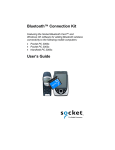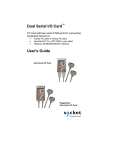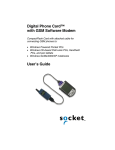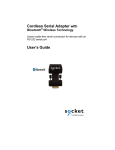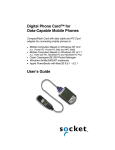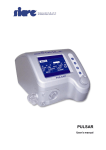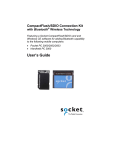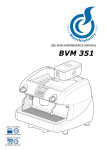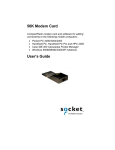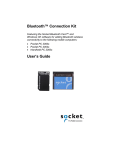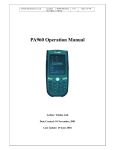Download Hi-Speed Digital Phone Card™ User`s Guide
Transcript
Hi-Speed Digital Phone Card™ for Newer Faster Cellular Data Networks CompactFlash Card with data cable for connecting a high-speed mobile phone to: • Pocket PC 2000 or Pocket PC 2002 • Handheld PC 2000 User’s Guide Table of Contents CHAPTER 1 INTRODUCTION 2 Overview About Socket’s Software Working Wirelessly with the DPC Contents of the Connection Kit 2 2 3 3 CHAPTER 2 PREPARING FOR INSTALLATION Register the Card Activate Mobile Phone Data Service Remove Old DPC Software CHAPTER 3 SETUP FOR POCKET PC 4 4 4 5 6 Installation Steps Summary STEP 1: Install the Software STEP 2: Complete the Connection Wizard STEP 3: Prepare the Phone STEP 4: Dial and Connect! OPTIONAL: Use Socket DPC Meter OPTIONAL: Check COM Port Number 6 6 8 10 11 15 17 CHAPTER 4 SETUP FOR HPC 2000 18 Installation Steps Summary STEP 1: Install the Software STEP 2: Complete the Connection Wizard STEP 3: Prepare the Phone STEP 4: Dial and Connect! OPTIONAL: Use Socket DPC Meter OPTIONAL: Check COM Port Number 18 18 20 22 23 25 26 APPENDIX A SPECIFICATIONS 27 APPENDIX B NETWORK INFORMATION FORM 28 APPENDIX C TROUBLESHOOTING 29 APPENDIX D SUPPORT RESOURCES 34 Users’ Forum Technical Support 34 34 LIMITED WARRANTY 35 COPYRIGHT NOTICE 37 REGULATORY COMPLIANCE 38 1 Chapter 1 Introduction Overview Thank you for purchasing Socket’s Hi-Speed Digital Phone Card. The card enables you to use your compatible mobile phone as a wireless modem, so there’s no need to set up additional contracts. You can take advantage of the new hi-speed networks with speeds bursting up to 144 kbps. When you use the Hi-Speed Digital Phone Card (DPC), you don’t need a modem, because your data-capable mobile phone simulates one. You can use the Hi-Speed Digital Phone Card with any application that you use with a regular modem, such as for email, file transfers or web browsing. About Socket’s Software Socket’s software takes the guesswork out of setting up a connection, calculating data call costs or identifying the COM port. Follow Socket’s DPC Setup software to quickly and easily set up a connection to your hi-speed network. The program automatically configures most of the necessary settings. The Socket DPC Meter helps you calculate the cost of your data call. Socket’s Hi-Speed COM Tools make it easy to identify the COM port assigned to the DPC. For software updates, visit: www.socketcom.com/support/support_dpc.htm 2 | CHAPTER 1: INTRODUCTION Working Wirelessly with the DPC Wireless Web Browsing Use the DPC to browse the Internet anytime anywhere within your mobile phone’s coverage area. Simply use the DPC to wirelessly connect to your office network or Internet Service Provider (ISP), open your web browser, and surf the Internet! The new Hi-Speed DPC, phone, and hi-speed cellular network service make downloading web pages much faster. Wireless Email You can set up your mobile computer’s Inbox to directly access your IMAP4-enabled exchange server or ISP’s POP3 user accounts. You can also use your web browser to access html-based email services. To learn more about mobile phones and wireless data communications, check out Socket’s technology brief, “Mobile Phone Basics,” at: www.socketcom.com/about/techbrief.htm Contents of the Connection Kit The Socket Hi-Speed Digital Phone Card for Pocket PCs package includes: • A Socket Hi-Speed Digital Phone Card (CompactFlash card Type I) with permanently attached data cable, customized for specific hi-speed mobile phones • The Socket Hi-Speed Digital Phone Card Installation CD Computer and Phone Compatibility The CompactFlash DPC works with a Pocket PC 2000, Pocket PC 2002 or Handheld PC 2000. You can use the CompactFlash card directly in a CompactFlash I/O slot. With a Type I CompactFlash-to-PC Card adapter, you can use the DPC in a PC Card slot. The adapter is available separately, SKU# AC4000-978 at www.esend.com/socket/. Your retail package may not list all the phones compatible with your version of the DPC. For updates, visit: www.socketcom.com/product/dpc.htm CHAPTER 1: INTRODUCTION | 3 Chapter 2 Preparing for Installation This chapter explains preliminary steps that should be completed prior to installing the Digital Phone Card. After completing the steps covered in this chapter, proceed to the appropriate chapter for the installation instructions for your specific type of computer. Important! If you do not complete the steps in this chapter before trying to install the Digital Phone Card, the installation may not run correctly! The four steps covered in this chapter include: • Registering your card • Activating data service for your mobile phone • Uninstalling old Socket DPC software Register the Card Register your DPC online at www.socketcom.com/product/prodreg.htm. Activate Mobile Phone Data Service You must activate data service on your mobile phone in order to use it with your Digital Phone Card. Some mobile phone carriers activate data service only when requested and charge extra fees for it. If necessary, ask your phone carrier for this feature. Data service is included with Verizon’s Express Network or Quick Net Connect (QNC), which are both compatible with the Hi-Speed Digital Phone Card. Important! If data service is not activated for your mobile phone, then you will not be able to use your phone for any data connections! 4 | CHAPTER 2: PREPARING FOR INSTALLATION Remove Old DPC Software Uninstall any old Socket DPC software you may have previously installed on your mobile computer. You can either uninstall the software directly from your mobile computer, or you can remove the software using ActiveSync on a host PC. OPTION 1: Uninstall Directly from the Mobile Computer 1. Make sure the Digital Phone Card software is closed, and remove the card from your mobile computer. Failure to do this will prevent completion of the uninstall process. 2. Go to Start | Settings. Tap on the System tab or Control Panel 3. Double or single tap on the Remove Programs icon 4. Select the DPC software, then tap on Remove. 5. Tap on Yes to confirm removal of the program OPTION 2: Uninstall via ActiveSync 1. Make sure the Digital Phone Card software is closed, and remove the card from your mobile computer. Failure to do this will prevent completion of the uninstall process. 2. Make an active connection between the mobile computer and host PC. An active connection exists if data can move between the mobile computer and host PC via a serial/Ethernet/USB connection cable or cradle. 3. On the host PC, open Microsoft ActiveSync 4. Click Tools | Add/Remove Programs. 5. Select the DPC software, then click Remove. 6. Select OK to confirm removal of the software on the mobile computer. 7. The next dialog will ask if you want to remove the software from your host PC. • Click NO to keep a copy of the software on your host PC that can later be re-installed. • Click YES to remove the software from the host PC. CHAPTER 2: PREPARING FOR INSTALLATION | 5 Chapter 3 Setup for Pocket PC This chapter explains how to set up the DPC for accessing a hi-speed network with a Pocket PC 2000 or Pocket PC 2002. Please note that hi-speed networks are not available in all areas. Important! Before you begin this chapter to install the Digital Phone Card, you must complete the steps in Chapter 2, “Preparing for Installation”!! Otherwise the installation may run incorrectly. Installation Steps Summary STEP 1: Install the software. STEP 2: Complete the connection wizard. STEP 3: Prepare the phone. STEP 4: Dial and connect! OPTIONAL: Use Socket DPC Meter OPTIONAL: Check COM Port Number STEP 1: Install the Software Follow these steps for software installation BEFORE inserting the DPC. 1. Make an active connection between the mobile computer and a host PC. An active connection exists if data can move between the Pocket PC and host PC via a serial/USB/Ethernet connection cable or cradle. 2. Insert the Socket Hi-Speed Digital Phone Card Installation CD into the CD drive of the host PC. 6 | CHAPTER 3: SETUP FOR POCKET PC 3. The setup program should auto-run. Follow the setup center to install the software for Windows CE. Note: If the program fails to auto-run, use My Computer or Windows Explorer to access your CD-ROM drive. Click on SETUP.EXE 4. In the File Download screen, select the option that lets you OPEN (or RUN) the file from its current location. WARNING! DO NOT SAVE THE FILE! IMPORTANT! YOU MUST OPEN THE FILE! DO NOT SAVE! 5. A Security Warning screen may appear. Click Yes. 6. The installation wizard will begin. Follow the instructions on the host PC screen until setup is done. 7. Disconnect the mobile computer from the host computer. CHAPTER 3: SETUP FOR POCKET PC | 7 STEP 2: Complete the Connection Wizard 1. After software installation, the DPC Setup program will automatically launch on your Pocket PC. Note: You can access the DPC Setup program at any time by doing the following: • If you have not soft reset the Pocket PC since installing the Socket software, press the reset button. • Go to Start | Settings | Connections. Tap on DPC Setup. 2. Follow the program to create a connection for your network. Note: Screens for the Verizon QNC will be shown as an example. Your screens may differ. In the first screen, select the network connection type. Tap Next>. The following screens will vary depending on what type of network you select. Standard Data Connection: Regular dial-up connection (up to 144 kbps). Complete the Network Information Form in Appendix B before setting up a standard data connection. Verizon Express Network: This connection uses Verizon’s Express Network, with data speeds up to 144 kbps. This service normally incurs extra charges. You need your mobile phone number to set up this connection. Verizon QNC (Quick Net Connect): This connection uses Verizon as the ISP. Data transmits at 14.4 kbps. If Verizon’s Express network is not available in your area, you can use QNC. 8 | CHAPTER 3: SETUP FOR POCKET PC 3. In the next screen, enter a name for the connection or accept the default name. Tap Next>. 4. The next screens will vary depending on what type of network you selected in the first screen. - Standard Data Connection: Enter your user name, password, and dial-up number as prompted. - Verizon Express Network: In the next screen, enter your mobile phone number. - Verizon QNC: Now you are ready to insert the card. See below. 5. As prompted, insert the DPC into your Pocket PC. If using a PC Card slot, first plug the card into a CompactFlash-to-PC Card adapter. Tap OK. 6. The last screen should report that you successfully set up the dial-up connection. Tap Finish. CHAPTER 3: SETUP FOR POCKET PC | 9 STEP 3: Prepare the Phone 1. Turn on your phone. Make sure it has enough battery power and is receiving a digital signal. For data calls, the signal strength should be at least two bars. If needed, raise the antenna, hold the phone upright and/or relocate to improve signal quality. 2. Connect the free end of the DPC cable to the data port of your mobile phone. The data port is typically the same port used to charge the phone. 3. Set your phone for the appropriate data rate/mode. Audiovox: • Press F►71. • Scroll to select the appropriate Service Mode. - Verizon Express Network: Select Packet High. . - Verizon Quick Net Connect: Select Circuit. - Standard connection: Select the appropriate mode for your network. Kyocera: • In the main screen, Menu should appear. Press ok. • Scroll to Settings, then press ok. • Scroll to Accessories, then press ok. • Scroll to COM Port Speed, then press ok. • Select the appropriate speed for your network and press ok . - Verizon Express Network: Select 230.4 kbps. . - Verizon Quick Net Connect: Select 19.2 kbps. - Standard connection: Select the appropriate speed for your network. Usually it will be 19.2 kbps. 10 | CHAPTER 3: SETUP FOR POCKET PC STEP 4: Dial and Connect! The procedure differs for the Pocket PC 2000 and Pocket PC 2002. Follow the appropriate instructions for your type of Pocket PC. Pocket PC 2000 1. Go to Start | Programs | Connections. Tap on your hi-speed connection. 2. In the Dial from drop-down menu, select Socket Wireless. Tap Connect. . Note: DPC-Express Network is shown as an example. Your user name and password may look different. 3. A screen will appear, reporting that the data call will incur extra charges. If desired, check Don’t display this again to stop this screen from appearing each time you use this connection. Tap OK. 4. A status screen will appear, reporting the progression of your data call. 5. After you successfully connect, the status screen will report Connected. Your device may also make a sound to denote the successful connection. 6. After a few seconds, the phone display should report that a data call is in progress. Now you are ready to use the connection for applications like ActiveSync, web browsing or email. CHAPTER 3: SETUP FOR POCKET PC | 11 Pocket PC 2002 1. Go to Start | Settings | Connections. Tap on the Connections icon. 2. Tap on the Dialing Locations tab. In the Location: field, select Socket Wireless. Tap on the Connections tab. 3. If you have multiple connections for your Internet Settings, you must assign the Pocket PC to “always dial” the new hi-speed connection. In the top field, select Internet Settings. Tap Modify. In the next screen, tap and hold your stylus on your hi-speed connection in the list. In the pop-up menu, select Always Dial. The bottom of the screen should now report that when dialing, your hi-speed connection will be used. Tap ok. 12 | CHAPTER 3: SETUP FOR POCKET PC 4. In the Connections screen, make sure Internet Settings is selected in the top field. Tap Connect. 5. A screen will appear, reporting that the data call will incur extra charges. Tap OK. Note: Check Don’t display this again to stop this screen from appearing each time you use this connection. 6. A connection status screen will appear, reporting the progress of your call. CHAPTER 3: SETUP FOR POCKET PC | 13 7. After you have successfully connected, the status screen will report Connected. Your device may also make a sound to denote a successful connection. 8. Your phone display should report that a data call is in progress. Now you are ready to use the connection for applications like ActiveSync, Internet browsing or email. Note: Your phone may enter dormant mode, but the Pocket PC will still be connected. Phone displays vary depending on network and phone model. Your Pocket PC will indicate your connection status. 14 | CHAPTER 3: SETUP FOR POCKET PC OPTIONAL: Use Socket DPC Meter The Socket DPC Meter helps you estimate the cost of both your last data call and the total of all your data calls. The meter can estimate cost based on price per minute or price per megabite. 1. Go to Start | Settings | Connections. Tap on Socket DPC Meter. Note: If the Socket DPC Meter icon does not appear, soft reset your mobile computer by pressing the reset button. 2. In the next screen, statistics for Duration and Data Amount of your last data call and all data calls since you last reset the meter should appear. 3. Check either Cost/Min or Cost/MB depending on how your data calls are charged. Then enter the price per unit for your data calls. 4. After a few seconds, the estimated cost for both your last call and all your calls since you last reset the meter will automatically appear. CHAPTER 3: SETUP FOR POCKET PC | 15 5. If you would like to erase all statistics in the meter, tap Reset. All statistics will begin again at 0. The cost per unit will stay. 6. Tap ok to exit the program. 16 | CHAPTER 3: SETUP FOR POCKET PC OPTIONAL: Check COM Port Number Socket’s Hi-Speed COM Tools utility application makes it easy to check which COM port is assigned to the DPC.* 1. Go to Start | Settings | Connections. 2. Tap on Hi-Speed COM Tools. Note: If the Hi-Speed COM Tools icon does not appear, soft reset your mobile computer by pressing the reset button. 3. Use the Ports screen to identify which COM port Windows has assigned to the DPC. 4. Tap ok to exit the application. * Advanced users can also use the Hi-Speed COM Tools to map baud rates. Most users will not need to use this for standard device applications. For more information about mapping baud rates, please contact Socket technical support at [email protected]. CHAPTER 3: SETUP FOR POCKET PC | 17 Chapter 4 Setup for HPC 2000 This chapter explains how to set up the DPC to access a hi-speed network with a Handheld PC 2000. Please note that hi-speed networks are not available in all areas. Important! Before you begin this chapter to install the Digital Phone Card, you must complete the steps in Chapter 2, “Preparing for Installation”!! Otherwise the installation may run incorrectly. Installation Steps Summary STEP 1: Install the software. STEP 2: Complete the connection wizard. STEP 3: Prepare the phone. STEP 4: Dial and connect! OPTIONAL: Use Socket DPC Meter OPTIONAL: Check COM Port Number STEP 1: Install the Software Follow these steps for software installation BEFORE inserting the DPC. 1. Make an active connection between the mobile computer and a host PC. An active connection exists if data can be move between the Pocket PC and host PC via a serial/USB/Ethernet connection cable or cradle. 2. Insert the Socket Hi-Speed Digital Phone Card Installation CD into the CD-ROM drive of the host PC. 18 | CHAPTER 4: SETUP FOR HPC 2000 3. The setup program should auto-run. Follow the setup center to install the software for Windows CE. Note: If the program fails to auto-run, use My Computer or Windows Explorer to access your CD-ROM drive. Click on SETUP.EXE 4. In the File Download screen, select the option that lets you OPEN (or RUN) the file from its current location. WARNING! DO NOT SAVE THE FILE! IMPORTANT! YOU MUST OPEN THE FILE! DO NOT SAVE! 5. A Security Warning screen may appear. Click Yes. 6. The installation wizard will begin. Follow the instructions on the host PC screen until setup is done. 7. Disconnect the mobile computer from the host computer. CHAPTER 4: SETUP FOR HPC 2000 | 19 STEP 2: Complete the Connection Wizard You must know the number of your mobile phone to set up a connection. 1. After software installation, the DPC Setup program will automatically launch on your HPC 2000. Note: You can access the DPC Setup program anytime by doing the following: • If you have not soft reset the Pocket PC since installing the Socket software, press the reset button. • Go to Start | Settings | Control Panel. Tap on DPC Setup. 2. Follow the program to create a connection for your hi-speed network. In the first screen, select the network type. Tap Next>. The program will vary depending on what network you select. Standard Data Connection: Regular dial-up connection (up to 144 kbps). Complete the Network Information Form in Appendix B before setting up a standard data connection. Verizon Express Network: This connection uses Verizon’s Express Network, with data speeds up to 144 kbps. This service normally incurs extra charges. You need your mobile phone number to set up this connection. Verizon QNC (Quick Net Connect): This connection uses Verizon as the ISP. Data transmits at 14.4 kbps. If Verizon’s Express network is not available in your area, you can use QNC. 3. In the next screen, enter a name for the connection or accept the default name. Tap Next>. 20 | CHAPTER 4: SETUP FOR HPC 2000 4. The following screens will vary depending on what type of network you selected in the first screen. - Standard Data Connection: Enter your user name, password, and dial-up number as prompted. - Verizon Express Network: In the next screen, enter your mobile phone number. - Verizon QNC: Now you are ready to insert the card. See below. 5. As prompted, insert the DPC into your HPC 2000. First plug the DPC into a CompactFlash-to PC Card adapter. Then insert the combined unit into your device’s PC Card slot. Tap OK. 6. In the last screen, tap Finish. CHAPTER 4: SETUP FOR HPC 2000 | 21 STEP 3: Prepare the Phone 1. Turn on your phone. Make sure it has enough battery power and is receiving a digital signal. For data calls, a signal strength of at least two bars is recommended. If needed, raise the antenna, hold the phone upright and/or relocate to improve signal quality. 2. Connect the free end of the DPC cable to the data port of your mobile phone. The data port is typically the same port used to charge the phone. 3. Set your phone for the appropriate COM port speed. Audiovox: • Press F►71. • Scroll to select the appropriate Service Mode. - Verizon Express Network: Select Packet High. . - Verizon Quick Net Connect: Select Circuit. - Standard connection: Select the appropriate mode for your network. Kyocera 2235: • In the main screen, Menu should appear. Press ok. • Scroll to Settings, then press ok. • Scroll to Accessories, then press ok. • Scroll to COM Port Speed, then press ok. • Select the appropriate speed for your network, then press ok. - Verizon Express Network: Select 230.4 kbps. - Verizon Quick Net Connect: Select 19.2 kbps. - Standard data connection: Select the appropriate speed for your network. Usually it will be 19.2 kbps. 22 | CHAPTER 4: SETUP FOR HPC 2000 STEP 4: Dial and Connect! 1. Go to Start | Programs | Communication | Remote Networking. 2. Click on the icon for the hi-speed connection you just set up. 3. The User Name and Password should already be entered. Tap on the Dial Properties button. 4. In the When dialing from: field, select Socket Wireless. Tap OK. 5. Tap Connect. CHAPTER 4: SETUP FOR HPC 2000 | 23 6. A screen will appear, reporting that the data call will incur extra charges. Tap OK. Note: To stop this screen from appearing before every data call, check Don’t display this again. 7. A status screen will appear, reporting the progression of your data call. 8. After you have successfully connected, the status screen will report Connected. Your device may also make a sound to denote connection success. 9. After a few seconds, your phone display should show that a data call is in progress. Now you are ready to use the connection for applications like ActiveSync, Internet browsing or email. Note: Your phone may enter dormant mode, but the HPC2000 will still be connected. Phone displays vary depending on network and phone model. Your HPC 2000 will indicate your connection status. 24 | CHAPTER 4: SETUP FOR HPC 2000 OPTIONAL: Use Socket DPC Meter The Socket DPC Meter helps you estimate the cost of both your last data call and the total of all your data calls. The meter can estimate cost based on price per minute or price per megabite. 1. Go to Start | Settings | Connections. 2. Tap on Socket DPC Meter. Note: If the Socket DPC Meter icon does not appear, soft reset your mobile computer by pressing the reset button. 3. In the next screen, statistics for the Duration and Data Amount of both your last data call and all data calls since you last reset the meter should appear. Check either Cost/Min or Cost/MB depending on how your data calls are charged. Then enter the price per unit for your data calls. 4. After a few seconds, the estimated cost of both your last data call and all data calls since you last reset the meter will automatically appear. 5. If you would like to erase all statistics currently in the meter, tap on Reset. All statistics will begin again at 0. The cost per unit will stay. 6. Tap X to exit the program. CHAPTER 4: SETUP FOR HPC 2000 | 25 OPTIONAL: Check COM Port Number Socket’s Hi-Speed COM Tools make it easy to check which COM port is assigned to the DPC. Note: The Advanced tab does not work with the DPC. 1. Go to Start | Settings | Control Panel. 2. Tap on Hi-Speed COM Tools. Note: If the Hi-Speed COM Tools icon does not appear, soft reset your HPC 2000 by pressing the reset button. 3. Use the Ports screen to identify which COM port Windows has assigned to the DPC. 4. Tap ok to exit the program. 26 | CHAPTER 4: SETUP FOR HPC 2000 Appendix A Specifications Physical Characteristics: CF I/O Card Size: 1.43 x 1.69 x 0.13 in (36.4 x 42.8 x 3.3 mm) Interconnect Cable Length: 22 in (559 mm) Power Consumption: Inactive: 0 mA (0 mW) Active (typical): 3 mA (10 mW) Interface Standards: CompactFlash Interface: CompactFlash I/O, Type I With CompactFlash-to-PC Card Adapter: PCMCIA, Type II Serial Communications: TTL Operating System Support: Windows CE HPC 2000, Pocket PC 2000 and Pocket PC 2002 Mobile Handsets Supported: Kits are available for selected Audiovox and Kyocera phones. Support for other manufacturers is pending. For the latest compatibility list and specific phone models, visit www.DigitalPhoneCard.com Software Compatibility: Windows COM port Software Included: Socket Hi-Speed Digital Phone Card Installation CD Compatible Applications: Windows Remote Dial-up, ActiveSync, Pocket Outlook, FTP, Telnet, AvantGO, Citrix, pcANYWHERE, BSquare applications, streaming video, etc. Warranty: CompactFlash Card and Non-removable Cable: Limited lifetime Certification: FCC: Part 15, Class B CE: EN55024:1998 C-TICK s.182 APPENDIX A: SPECIFICATIONS | 27 Appendix B Network Information Form Important! If you plan to connect to Verizon Quick Net Connect or Verizon Express Network, you DO NOT need to complete this form. Complete the form below if you plan to use a standard connection. Contact your network administrator or Internet Service Provider (ISP) for help. If you plan to use ISP services from your mobile phone carrier, contact your carrier. For a text-only version you can email, go to the Docs folder on the installation CD or visit: www.socketcom.com/support/support_dpc.htm 1. Please provide the following dial-up information: Dial-up number: ( ____ ) _______________ User name: _________________________ Password: _________________________ Domain: __________________________ 2. Does the network support DHCP (Dynamic Host Configuration Protocol)? YES. If Yes, then STOP. You DO NOT need to answer Question 3. NO. If No, then continue to Question 3. 3. Please specify any applicable IP addresses: (a) Mobile Computer IP address: _____ . _____ . _____ . _____ (b) Subnet Mask: _____ . _____ . _____ . _____ (c) Default Gateway: _____ . _____ . _____ . _____ (d) Primary DNS: _____ . _____ . _____ . _____ (e) Secondary DNS: _____ . _____ . _____ . _____ (f) Primary WINS: _____ . _____ . _____ . _____ (g) Secondary WINS: _____ . _____ . _____ . _____ Remote ActiveSync only: If your server does NOT have WINS services enabled, you must use the IP address of your host computer instead of a Primary WINS address. (h) Host computer IP address: _____ . _____ . _____ . _____ 28 | APPENDIX B: NETWORK INFORMATION FORM Appendix C Troubleshooting SYMPTOM: • My computer does not recognize my phone and/or AT commands • I cannot place a call. POSSIBLE REASONS Your phone is not turned on. Your phone is not communicating properly with your computer. The cable between your phone and the DPC is not connected correctly. Other software is using the COM port. SOLUTION Turn on your phone. Turn your phone off, then turn it on again. Make sure you are using the correct cable for your phone and that all connectors are securely fastened. Deactivate the software that is using the COM port. ActiveSync usually uses the same COM port. SYMPTOM: • My call fails immediately OR • I get CALL FAILED on my mobile phone. POSSIBLE REASONS The phone battery has run out of power. Temporary network problems. Your service provider won’t accept low bandwidth connections. SOLUTION Charge or replace the battery. Try the call again. CALL FAILED usually disappears after a second try. If you still get CALL FAILED, turn your phone off then on again. If this doesn't resolve the problem, your wireless service may be down. Contact your service provider. APPENDIX C: TROUBLESHOOTING | 29 SYMPTOM: • I get disconnected in mid-session. POSSIBLE REASONS The digital signal has faded, or you have traveled outside the mobile coverage area. Your phone battery has run out of power. The data cable between your mobile phone and your computer is loose or has become disconnected. The modem at your Internet Service Provider has hung up. Your call was dropped. You were automatically disconnected due to inactivity. SOLUTION Raise the phone antenna. On your phone display, there should be an icon to indicate digital coverage. If you have left the coverage area, return to it and try again. Charge or replace the battery. Make sure the data cable is securely fastened to your phone. Your corporate network or Internet Service Provider may terminate your call for many reasons. Try calling again. If the problem persists, contact your Internet Service Provider. Try the call again. Some software will automatically end a call after a period of inactivity. Check your software for automatic disconnection settings. SYMPTOM: • I get a NETWORK NOT RESPONDING message on my mobile phone. POSSIBLE REASONS Your need to update your mobile account. SOLUTION Call your mobile service provider. 30 | APPENDIX C: TROUBLESHOOTING SYMPTOM: • My computer dials but cannot connect. POSSIBLE REASONS You have multiple modems set up on your computer, and the software is configured for a modem other than the mobile phone. You are dialing the wrong number. The number you are dialing is long distance. You are using a dialing prefix — such as a 9 — before the phone number. The modem you are calling is out of service. Your phone signal is weak. Your user name and/or password is incorrect. SOLUTION Configure your communications software for a DPC connection. Select the DPC as the modem. Check the number, including the area code. Contact your Internet Service Provider to verify the number. Check the area code of the number you are dialing. You may need to add a 1 before the number for long distance calls. Remove any dialing prefixes from the phone number. Contact your Internet Service Provider or corporate network support to verify the status of their server and modems. Raise the phone antenna. On your phone display, there should be an icon to indicate digital coverage. If you are outside the coverage area, change locations and call again. Check that you have entered the proper user name and password. SYMPTOM: • I get a DISCONNECTED SIGNAL FADED message on my mobile phone. POSSIBLE REASONS You left the mobile coverage area during the call. SOLUTION Change locations and call again. APPENDIX C: TROUBLESHOOTING | 31 SYMPTOM: • My mobile phone shows that the call has connected but my communications software does not. POSSIBLE REASONS The call took so long to establish that the communications software gave up (timed out). SOLUTION Increase the time-out interval on your communications software and try the call again. SYMPTOM: • My communications software shows the call has connected, but my mobile phone does not. POSSIBLE REASONS Your call was dropped, but your communications software is still waiting to connect. SOLUTION Cancel the call from your communications software and try again. SYMPTOM: • I cannot receive voice calls. POSSIBLE REASONS You have set up your mobile phone to receive data or fax calls only. You are engaged in a data call. SOLUTION Follow the instructions that came with your phone to configure for voice calls instead of fax or data calls. You can usually access this feature from the phone's menu. During data calls, you cannot receive voice calls. Hang up and, if necessary, switch your phone back to voice mode. SYMPTOM: • The icons for DPC Setup and Hi-Speed COM Tools don’t appear. POSSIBLE REASONS You have not soft reset your mobile computer after software installation. SOLUTION Soft reset your mobile computer by pressing the reset button. 32 | APPENDIX C: TROUBLESHOOTING SYMPTOM: • I cannot receive data calls. POSSIBLE REASONS The phone is not set up to receive data calls. Your communications software is not answering in time. SOLUTION Follow the instructions that came with your phone to set up the phone to receive data calls. You can usually access this feature from the phone's menu. Set your communications software to answer after fewer rings, preferably 0. Consult the software's user manual for instructions. SYMPTOM: • The data is transmitting slowly. POSSIBLE REASONS CDMA networks have a maximum connection speed of 14,400 bps. GSM networks have a maximum connection speed of 9,600 bps. Dial-in or web servers have heavy traffic. SOLUTION Visit Socket’s web site at www.DigitalPhoneCard.com for suggestions on how to use your system more efficiently. Connect at a different time, when your network or ISP is less busy. SYMPTOM: • I cannot access my email and/or use my web browser. POSSIBLE REASONS You are not connected to your corporate network or Internet Service Provider. Your dial-up networking settings are incorrect. Your user name(s) and/or password(s) are incorrect. SOLUTION Connect again. Check that your dial-up networking settings match those provided by your office network support or ISP. Check that you have entered the proper user name and password for your various services, including email accounts and proxy servers. APPENDIX C: TROUBLESHOOTING | 33 Appendix D Support Resources Users’ Forum If you would like to discuss the Hi-Speed Digital Phone Card with other users, visit Socket’s users’ forum at www.socketforum.com. Technical Support If have technical problems with the Digital Phone Card, please refer to Appendix C, “Troubleshooting.” If problems persist, feel free to contact Socket’s technical support department for help, prepared with the following information: • The part number (including revision level) and serial number of your DPC. See the diagram below. • The manufacturer, model number, and operating system version of your mobile computer • The manufacturer, model number and carrier of your mobile phone • If applicable, the version of Windows on your host PC • What the problem is and how you have tried to correct the problem To reach Socket’s technical support department: • Visit www.socketcom.com/support/contact.htm • Email [email protected] • Phone 510-744-2720 • Fax 510-744-2727 Please refrain from disassembling the Digital Phone Card. Disassembly will void the product warranty. 34 | APPENDIX D: SUPPORT RESOURCES Limited Warranty Socket Communications Incorporated (Socket) warrants this product against defects in material and workmanship, under normal use and service, for the following periods from the date of purchase: Plug-in card: Lifetime (Three years if not registered) Non-removable cable: Lifetime (Three years if not registered) Incompatibility is not a defect covered by Socket’s warranty. During the warranty period, Socket will, at its option, repair or replace the defective product at no charge when furnished with proof of retail purchase, provided that you deliver the product to Socket or to an authorized Socket Service Center. The returned product must be accompanied by a return material authorization (RMA) number issued by Socket or by Socket's Authorized Service Center. If you ship the product, you must use the original container or equivalent and you must pay the shipping charges to Socket. Socket will pay shipping charges back to any location in the contiguous United States. This warranty applies only to the original retail purchaser and is not transferable. Socket may, at its option, replace or repair the product with new or reconditioned parts and the returned product becomes Socket's property. Socket warrants the repaired or replaced products to be free from defects in material or workmanship for ninety (90) days after the return shipping date, or for the duration of the original warranty period, whichever is greater. This warranty does not cover the replacement of products damaged by abuse, accident, misuse or misapplication, nor as a result of service or modification other than by Socket. SOCKET IS NOT RESPONSIBLE FOR INCIDENTAL OR CONSEQUENTIAL DAMAGES RESULTING FROM BREACH OF ANY EXPRESS OR IMPLIED WARRANTY, INCLUDING DAMAGE TO PROPERTY AND, TO THE EXTENT PERMITTED BY LAW, DAMAGES FOR PERSONAL INJURY. THIS WARRANTY IS IN LIEU OF ALL OTHER WARRANTIES INCLUDING IMPLIED WARRANTIES OF MERCHANTABILITY AND FITNESS FOR A PARTICULAR PURPOSE. Some states do not allow limitation of implied warranties, or the exclusion or limitation of incidental or consequential damages, so that the above limitations or exclusions may not apply to you. This warranty gives you specific legal rights and you may also have other rights which vary from state to state. This product may contain fully tested, recycled parts, warranted as if new. For warranty information, phone (510) 744-2700. 35 Limited Software Warranty LIMITED WARRANTY. SOCKET warrants that the original disk or CD ROM is free from defects for 90 days from the date of delivery of the SOFTWARE. CUSTOMER REMEDIES. SOCKET’S entire liability and your exclusive remedy shall be, at SOCKET’S option, either (a) return of the price paid or (b) replacement of the SOFTWARE which does not meet SOCKET’S Limited Warranty and which is returned to SOCKET with a copy of your receipt. Any replacement SOFTWARE will be warranted for the remainder of the original warranty period or 30 days, whichever is longer. THESE REMEDIES ARE NOT AVAILABLE OUTSIDE OF THE UNITED STATES OF AMERICA. NO OTHER WARRANTIES. SOCKET disclaims all other warranties, either express or implied, including but not limited to implied warranties of merchantability and fitness for a particular purpose, with respect to the SOFTWARE and the accompanying written materials. This limited warranty gives you specific legal rights. You may have others which vary from state to state. NO LIABILITY FOR CONSEQUENTIAL DAMAGES. In no event shall SOCKET or its suppliers be liable for any damages whatsoever (including, without limitation, damages for loss of business profits, business interruption, loss of business information, or other pecuniary loss) arising out of the use of or inability to use the SOFTWARE, even if SOCKET has been advised of the possibility of such damages. Because some states do not allow the exclusion or limitation of liability for consequential or incidental damages, the above limitation may not apply to you. EXPORT LAW ASSURANCES. You may not use or otherwise export or reexport the SOFTWARE except as authorized by United States law and laws of the jurisdiction in which the SOFTWARE was obtained. In particular, but without limitation, none of the SOFTWARE may be used or otherwise exported or reexported (a) into (or to a national or resident of) a United States embargoed country or (b) to anyone on the U.S. Treasury Department’s list of Specially Designated Nationals or the U.S. Department of Commerce’s Table of Denial Orders. By using the SOFTWARE, you represent and warrant that you are not located in, under control of, or a national or resident of any such country or on any such list. GOVERNMENT END USERS. If the SOFTWARE is supplied to the U. S. Government, the SOFTWARE is classified as “restricted computer software” as defined in clause 52.227-19 of the FAR. The U. S. Government ‘s rights to the SOFTWARE are as provided in clause 52.227-19 of the FAR. CONTROLLING LAW AND SEVERABILITY. This License shall be governed by the laws of the United States and the State of California. If for any reason a court of competent jurisdiction finds any provision, or portion thereof, to be unenforceable, the remainder of this License shall continue in full force and effect. 36 August 2002 Document # 6410-00186 B Copyright Notice Copyright © 2002 Socket Communications, Inc. All rights reserved. Socket, the Socket logo and Battery Friendly are registered trademarks of Socket Communications, Inc. Digital Phone Card is a trademark of Socket Communications, Inc. All other brand and product names are trademarks of their respective holders. The Digital Phone Card includes technology licensed under United States Patent Nos. 4,543,450, 4,603,320, 4,686,506, and 4,972,470. Reproduction of the contents of this manual without the permission of Socket Communications is expressly prohibited. Please be aware that the products described in this manual may change without notice. Feel free to contact SOCKET COMMUNICATIONS at: Socket Communications, Inc. 37400 Central Court Newark, CA 94560 Phone: (510) 744-2700 Fax: (510) 744-2727. Technical support: (510) 744-2720. Important! Before calling for technical support, please prepare yourself with the information listed in Appendix B, “Support Resources.” Other than the above, Socket Communications can assume no responsibility for anything resulting from the application of information contained in this manual. Socket Communications requests that you refrain from any applications of the Socket Digital Phone Card that are not described in this manual. Socket Communications also requests that you refrain from disassembling the Digital Phone Card. Disassembly of this device will void the product warranty. You can track new product releases, software updates and technical bulletins by visiting Socket’s web page at: www.DigitalPhoneCard.com. 37 Regulatory Compliance The Socket Digital Phone Card is designed to be compliant with the rules and regulations in locations where they are sold and will be labeled as required. This product is type approved — users are not required to obtain license or authorization before using. Radio Frequency Interference Requirements This device complies with part 15 of the FCC rules. Operation is subject to the following conditions: (1) This device may not cause harmful interference, and (2) this device must accept any interference received, including interference that may cause undesired operation. This equipment is also ETS 300 328, ETS 300 826 and C-TICK compliant. These limits are designed to provide reasonable protection against harmful interference when the equipment is operated in a commercial environment. This equipment generates, uses, and can radiate radio frequency energy and, if not installed and used in accordance with the instruction manual, may cause harmful interference to radio communications. Operation of this equipment in a residential area is likely to cause harmful interference in which case the user will be required to correct the interference at his or her own expense. If this equipment does cause harmful interference to radio or television reception, which can be determined by turning the equipment off and on, the user may try to correct the interference by one or more of the following measures: • • • • Reorient or relocate the receiving antenna of the radio or television. Increase the distance separating the equipment and the receiver. Connect the equipment to an outlet on a different branch circuit than that of the receiver. Consult the dealer or an experienced radio/TV technician for help. The user may find the following booklet helpful: How to Identify and Resolve Radio-TV Interference Problems This booklet is available from the U.S. Government Printing Office, Washington, D.C. 20402. 38 Radio Frequency Interference Requirements – Canada This Class B digital apparatus meets the requirements of the Canadian Interference-Causing Equipment Regulations. Cet appareil numérique de la Classe B respecte toutes les exigencies du Reglement sur le Matériel Brouilleur du Canada. NOTE: To comply with FCC and Industry Canada exposure requirements, this device is approved for operations in a user’s hand when there is a distance of 20 cm or more between the device antenna and the user’s body. CE Marking & European Union Compliance Products intended for sale within the European Union are marked with a CEMark which indicates compliance to applicable Directives and European Normes (EN), as follows. Amendments to these Directives or ENs are included: Normes (EN), as follows: Applicable Directives: • Electromagnetic Compatibility Directive 89/336/EEC • Low Voltage Directive 73/23/EEC Applicable Standards: • EN 55 022 – Limits and Methods of Measurement of Radio Interference Characteristics of Information Technology Equipment. • EN 50 082-1 – Electromagnetic Compatibility – General Immunity Standard, Part 1: Residential, Commercial, Light Industry. • IEC 801.2 – Electromagnetic Compatibility for Industrial Process Measurement and Control Equipment, Part 2: Electrostatic Discharge Requirements. • IEC 801.3 – Electromagnetic Compatibility for Industrial Process Measurement and Control Equipment, Part 3: Radiated Electromagnetc Field Requirements. • IEC 801.4 - Electromagnetic Compatibility for Industrial Process Measurement and Control Equipment, Part 4: Electrical Fast Transients Requirements. • EN 60 950 + Amd 1 + Amd 2 – Safety of Information Technology Equipment Including Business Equipment. 39 Printed in U.S.A.










































